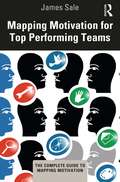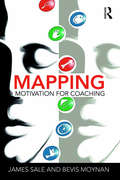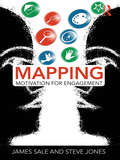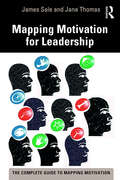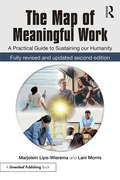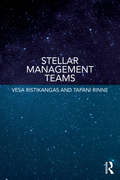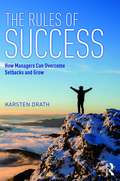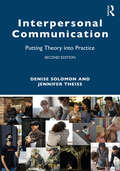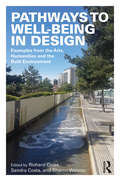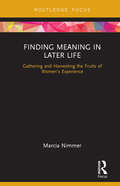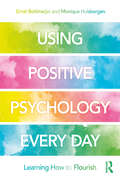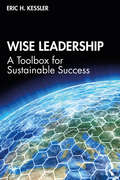- Table View
- List View
Mapping Motivation for Top Performing Teams (The Complete Guide to Mapping Motivation)
by James SaleMapping Motivation for Top Performing Teams is the final volume in a series of books that are all linked to the author's Motivational Map toolkit. Each book builds on a different aspect of personal, team and organisational development. This book, using the Motivational Map, the Team Motivational Map, as well as the Organisation Motivational Map, is a practical guide to understanding how team dynamics and success are hugely influenced by motivational factors, which are not usually taken into account. The book is a deeper exploration of team mapping which occurs in Chapter 6 of Mapping Motivation (2015), Chapter 6 of Mapping Motivation for Engagement (with Steve Jones, 2019), and Chapter 6 of Mapping Motivation for Leadership (with Jane Thomas, 2020). But whereas these chapters only touched on specific aspects of team dynamics, this book covers the issues more comprehensively; it also attempts to avoid replication of materials, although there are bound to be small overlaps. It covers not only how motivations affect team productivity and how this can be boosted through targeted Reward Strategies, but also how ‘mapping’ provides profounder insights into the four key characteristics of top performing teams: the clear remit, vital interdependency, strong belief, and real accountability. How Motivational Maps covers these areas, we believe to be original, eye-opening and effective in the management of change. Further, as always with Motivational Maps, its language and metrics raise self-awareness at an individual and team level, and so can help resolve conflicts through its common and non-judgmental language. Managing teams is the key skill of managers: thus this book is a handbook for managers everywhere who wish to excel at management, for without bringing their teams on board (i.e. motivating their teams), they are not effectively managing.
Mapping Motivation for Top Performing Teams (The Complete Guide to Mapping Motivation)
by James SaleMapping Motivation for Top Performing Teams is the final volume in a series of books that are all linked to the author's Motivational Map toolkit. Each book builds on a different aspect of personal, team and organisational development. This book, using the Motivational Map, the Team Motivational Map, as well as the Organisation Motivational Map, is a practical guide to understanding how team dynamics and success are hugely influenced by motivational factors, which are not usually taken into account. The book is a deeper exploration of team mapping which occurs in Chapter 6 of Mapping Motivation (2015), Chapter 6 of Mapping Motivation for Engagement (with Steve Jones, 2019), and Chapter 6 of Mapping Motivation for Leadership (with Jane Thomas, 2020). But whereas these chapters only touched on specific aspects of team dynamics, this book covers the issues more comprehensively; it also attempts to avoid replication of materials, although there are bound to be small overlaps. It covers not only how motivations affect team productivity and how this can be boosted through targeted Reward Strategies, but also how ‘mapping’ provides profounder insights into the four key characteristics of top performing teams: the clear remit, vital interdependency, strong belief, and real accountability. How Motivational Maps covers these areas, we believe to be original, eye-opening and effective in the management of change. Further, as always with Motivational Maps, its language and metrics raise self-awareness at an individual and team level, and so can help resolve conflicts through its common and non-judgmental language. Managing teams is the key skill of managers: thus this book is a handbook for managers everywhere who wish to excel at management, for without bringing their teams on board (i.e. motivating their teams), they are not effectively managing.
Mapping Motivation for Coaching (The Complete Guide to Mapping Motivation)
by James Sale Bevis MoynanMapping Motivation for Coaching, co-written with Bevis Moynan, is the first of a series of six books that are all linked to the author's Motivational Map toolkit. Each book builds on a different aspect of personal, team, and organisational development. This book is a practical guide to understanding how personal and career development is underpinned by motivation, and how coaching and mapping are perfectly complementary activities. More specifically, it shows how using Motivational Maps within an accepted coaching framework can not only accelerate the process in order to achieve results for the client more quickly, but also go deeper, both in mutual understanding and also the possibility of facilitating a successful outcome; for the client not only needs to understand their issue more effectively through the coaching process, but also needs to be motivated to want to take significant action to deal with it. Understanding, then, is one thing, but having the energy for follow-through is another, and it is precisely in this area that combining Maps with coaching techniques is so powerful. This highly original approach will enable all coaches everywhere in the world to get into the heart of their clients’ issues faster, better, and be able to help them solve these issues more easily.
Mapping Motivation for Coaching (The Complete Guide to Mapping Motivation)
by James Sale Bevis MoynanMapping Motivation for Coaching, co-written with Bevis Moynan, is the first of a series of six books that are all linked to the author's Motivational Map toolkit. Each book builds on a different aspect of personal, team, and organisational development. This book is a practical guide to understanding how personal and career development is underpinned by motivation, and how coaching and mapping are perfectly complementary activities. More specifically, it shows how using Motivational Maps within an accepted coaching framework can not only accelerate the process in order to achieve results for the client more quickly, but also go deeper, both in mutual understanding and also the possibility of facilitating a successful outcome; for the client not only needs to understand their issue more effectively through the coaching process, but also needs to be motivated to want to take significant action to deal with it. Understanding, then, is one thing, but having the energy for follow-through is another, and it is precisely in this area that combining Maps with coaching techniques is so powerful. This highly original approach will enable all coaches everywhere in the world to get into the heart of their clients’ issues faster, better, and be able to help them solve these issues more easily.
Mapping Motivation for Engagement (The Complete Guide to Mapping Motivation)
by James Sale Steve JonesEmployee engagement is undeniably a crucial focus point for organisations in the twenty-first century, with motivation comprising the often missing, but vital, component of the developmental mix. Mapping Motivation for Engagement advocates a new paradigm for the twenty-first century: away from hierarchies and command-and-control management styles, towards a bottom-up approach in which the needs and motivators of the employees take centre stage. Co-written with Steve Jones, this is the third in a series of books that are all linked to the author James Sale’s Motivational Map diagnostic tool. Each book builds on a different aspect of personal, team and organisational development. This book is a practical guide to the complexities of understanding and dealing with engagement in modern organisational life. Along with clear diagrams, reflective points, activities and a comprehensive index, the book provides free access to the online Motivational Map tool to facilitate a greater understanding of the contents. Drawing on copious amounts of the latest research, as well as models like the Macleod Report for the UK government, this book shows how Mapping Motivation can play a significant and crucial role in making engagement a reality, instead of a dream. Mapping Motivation for Engagement is a stimulating and thought-provoking read for a wide audience including, but not limited to, trainers and coaches working in management and motivation, experts in human resources, internal learning and development and organisational development as well as change and engagement consultants and specialists.
Mapping Motivation for Leadership (The Complete Guide to Mapping Motivation)
by James Sale Jane ThomasMapping Motivation for Leadership, co-written with Jane Thomas, is the fourth of a series of seven books that are all linked to the author’s Motivational Map toolkit. Each book builds on a different aspect of personal, team and organisational development. This is a practical guide to leadership in the 21st century and builds on the ‘4+1’ model outlined in the author's original book Mapping Motivation: Unlocking the Key to Employee Energy and Engagement. There is an increasing body of evidence, that the single most important aspect of being a leader relates to managing emotions effectively, and this management goes way beyond simply ‘understanding’ emotional intelligence; it is in fact a practice and one that is intimately connected with personal development and growth, and with energy. Energy, as Mapping Motivation made clear, is synonymous with motivation. The effective leaders of tomorrow will be those who understand their motivators, who regularly measure their motivators, sustain and replenish and maximise their motivators, and who do the same for their employees. Clearly, there is a link here with the book on engagement, for leaders who do so will engage their employees. However, this book not only covers the motivational side of leadership, but also explores in detail the skill sets necessary in the ‘4+1’ model: thinking skills, action skills, team skills and motivational skills plus that indefinable ‘something’ that is a commitment to personal development, so that we as leaders are not trying to solve today’s problems with yesterday’s training as our only internal resource.
Mapping Motivation for Leadership (The Complete Guide to Mapping Motivation)
by James Sale Jane ThomasMapping Motivation for Leadership, co-written with Jane Thomas, is the fourth of a series of seven books that are all linked to the author’s Motivational Map toolkit. Each book builds on a different aspect of personal, team and organisational development. This is a practical guide to leadership in the 21st century and builds on the ‘4+1’ model outlined in the author's original book Mapping Motivation: Unlocking the Key to Employee Energy and Engagement. There is an increasing body of evidence, that the single most important aspect of being a leader relates to managing emotions effectively, and this management goes way beyond simply ‘understanding’ emotional intelligence; it is in fact a practice and one that is intimately connected with personal development and growth, and with energy. Energy, as Mapping Motivation made clear, is synonymous with motivation. The effective leaders of tomorrow will be those who understand their motivators, who regularly measure their motivators, sustain and replenish and maximise their motivators, and who do the same for their employees. Clearly, there is a link here with the book on engagement, for leaders who do so will engage their employees. However, this book not only covers the motivational side of leadership, but also explores in detail the skill sets necessary in the ‘4+1’ model: thinking skills, action skills, team skills and motivational skills plus that indefinable ‘something’ that is a commitment to personal development, so that we as leaders are not trying to solve today’s problems with yesterday’s training as our only internal resource.
The Map of Meaningful Work (2e): A Practical Guide to Sustaining our Humanity
by Marjolein Lips-Wiersma Lani MorrisThis book introduces the Map of Meaning which provides a clear, simple and profound framework of the dimensions and process of living and working meaningfully. The Map of Meaning is based on over 20 years' research into the insights and practice of ordinary people as they search for, lose and find meaning. Incorporating the ideas of philosophers, psychologists and sociologists, this book describes how human beings wrestle with, and answer, questions such as, "What gives my life and work meaning?", "How can I balance inspiration and reality and maintain positive momentum?" and "How do we integrate meaningfulness into our workplaces?". Innate human knowledge is captured in a practical model that makes understanding and working with issues of meaning clear and accessible to everyone. At an individual level this book helps people to define and stay in contact with what is most important to them as they grapple with the real problems of daily life. It shows how they can stay in charge of keeping the human search for meaning alive, especially in the face of the challenges that exist in organizational life. Because the dimensions of meaning are shared, the second half of the book focuses on how we can bring an awareness of what creates meaningful work into our thinking about the practice and design of organisations. The authors recognize that in the current economic context a simple, yet profound guide for humanity is essential, precisely because organizational life has become so intensely directed towards a singular economic goal. They argue that it is vital that people have an easy, powerful way to reclaim the significance of meaning in their working lives both individually and at a whole of organization level. Updated with new chapter material and case studies, this second edition offers profound insights for anyone who is interested in creating more meaning and purpose in work and organizations – from a CEO to a blue-collar worker or consultant. It is for those searching for ways to re-energize their roles or change their careers. It is for anyone who firmly believes that it must be possible to align our deeper life purposes with our daily actions in the workplace. It is for anyone who is committed to creating workplaces that support and enable the experience of work that feels worth doing.
The Map of Meaningful Work (2e): A Practical Guide to Sustaining our Humanity
by Marjolein Lips-Wiersma Lani MorrisThis book introduces the Map of Meaning which provides a clear, simple and profound framework of the dimensions and process of living and working meaningfully. The Map of Meaning is based on over 20 years' research into the insights and practice of ordinary people as they search for, lose and find meaning. Incorporating the ideas of philosophers, psychologists and sociologists, this book describes how human beings wrestle with, and answer, questions such as, "What gives my life and work meaning?", "How can I balance inspiration and reality and maintain positive momentum?" and "How do we integrate meaningfulness into our workplaces?". Innate human knowledge is captured in a practical model that makes understanding and working with issues of meaning clear and accessible to everyone. At an individual level this book helps people to define and stay in contact with what is most important to them as they grapple with the real problems of daily life. It shows how they can stay in charge of keeping the human search for meaning alive, especially in the face of the challenges that exist in organizational life. Because the dimensions of meaning are shared, the second half of the book focuses on how we can bring an awareness of what creates meaningful work into our thinking about the practice and design of organisations. The authors recognize that in the current economic context a simple, yet profound guide for humanity is essential, precisely because organizational life has become so intensely directed towards a singular economic goal. They argue that it is vital that people have an easy, powerful way to reclaim the significance of meaning in their working lives both individually and at a whole of organization level. Updated with new chapter material and case studies, this second edition offers profound insights for anyone who is interested in creating more meaning and purpose in work and organizations – from a CEO to a blue-collar worker or consultant. It is for those searching for ways to re-energize their roles or change their careers. It is for anyone who firmly believes that it must be possible to align our deeper life purposes with our daily actions in the workplace. It is for anyone who is committed to creating workplaces that support and enable the experience of work that feels worth doing.
Stellar Management Teams
by Vesa Ristikangas Tapani RinneManagement teams at all levels, and individual team members in particular, are often disengaged and disconnected from the management function itself. Statements such as, "we lack common goals or they are unclear", "I have no influence", "I am not listened to nor taken into account", and "I do not feel valued – actually, nobody does", are commonplace. The authors argue this is because we have been entrenched in an era of guru leadership but that it must come to an end if our management teams are to rise to the top. An individual is not capable of controlling the complicated system of an organization, with its countless variables, especially in conjunction with the rapid change in both the economy and market forces, which are unpredictable and uncontrollable. No matter how talented the individual, no one person is in a position to manage this complex system alone – not even a guru leader. The authors contend that what is needed now are resilient trendsetters who will bring about a new era of top-performing teams that together form a "collective guru", which they refer to as a Stellar Management Team. In this book, the reader undertakes a metaphorical journey to the stars, which symbolizes top-level interaction and collaboration. The journey is the development from an ordinary management team into a Stellar Management Team, which elevates its operation up to a new level of performance and success.
Stellar Management Teams
by Vesa Ristikangas Tapani RinneManagement teams at all levels, and individual team members in particular, are often disengaged and disconnected from the management function itself. Statements such as, "we lack common goals or they are unclear", "I have no influence", "I am not listened to nor taken into account", and "I do not feel valued – actually, nobody does", are commonplace. The authors argue this is because we have been entrenched in an era of guru leadership but that it must come to an end if our management teams are to rise to the top. An individual is not capable of controlling the complicated system of an organization, with its countless variables, especially in conjunction with the rapid change in both the economy and market forces, which are unpredictable and uncontrollable. No matter how talented the individual, no one person is in a position to manage this complex system alone – not even a guru leader. The authors contend that what is needed now are resilient trendsetters who will bring about a new era of top-performing teams that together form a "collective guru", which they refer to as a Stellar Management Team. In this book, the reader undertakes a metaphorical journey to the stars, which symbolizes top-level interaction and collaboration. The journey is the development from an ordinary management team into a Stellar Management Team, which elevates its operation up to a new level of performance and success.
The Rules of Success: How Managers Can Overcome Setbacks and Grow
by Karsten DrathThis book is about the rules of long-term professional success. The international study on which this book is based suggests that success is, above all, one thing: the quest for a combination of happiness and satisfaction, coupled with economic independence. However, the data also suggest that the definition of success varies significantly from person to person. And furthermore, it seems like success is not an objective quality, but at least partly it results from a process of comparison with a peer group - which means in turn that the selection of your peer group is crucial for your perceived level of success in life. The author argues that, in fact, certain success factors do exist and that they are fewer in number than one might think. But above all, if we look thoroughly at the lives of truly successful people, it soon becomes apparent that success primarily has to do with overcoming setbacks, failure and crisis. This ability to effectively process adversity is also known as resilience. Because of its criticality for success this concept is discussed in greater depth using the FiRE model (Factors improving Resilience Effectiveness) as a structure. This concept has been developed by the author through many years of research. It differs from existing models due to its holistic approach including analysing different disciplines of science such as biology, medicine, brain research, epigenetics, sociology, psycho-neuro-immunology etc.
The Rules of Success: How Managers Can Overcome Setbacks and Grow
by Karsten DrathThis book is about the rules of long-term professional success. The international study on which this book is based suggests that success is, above all, one thing: the quest for a combination of happiness and satisfaction, coupled with economic independence. However, the data also suggest that the definition of success varies significantly from person to person. And furthermore, it seems like success is not an objective quality, but at least partly it results from a process of comparison with a peer group - which means in turn that the selection of your peer group is crucial for your perceived level of success in life. The author argues that, in fact, certain success factors do exist and that they are fewer in number than one might think. But above all, if we look thoroughly at the lives of truly successful people, it soon becomes apparent that success primarily has to do with overcoming setbacks, failure and crisis. This ability to effectively process adversity is also known as resilience. Because of its criticality for success this concept is discussed in greater depth using the FiRE model (Factors improving Resilience Effectiveness) as a structure. This concept has been developed by the author through many years of research. It differs from existing models due to its holistic approach including analysing different disciplines of science such as biology, medicine, brain research, epigenetics, sociology, psycho-neuro-immunology etc.
Interpersonal Communication: Putting Theory into Practice
by Denise Solomon Jennifer TheissThis fully revised text demystifies interpersonal communication skills by bringing the latest research together with practical guidance that prepares students to discern key communication dynamics and communicate more effectively in all areas of their lives. The new edition draws on current theory and research to guide students through the foundations of the discipline, recent developments in scientific research, and tips for improving their own interpersonal communication skills. In addition, readers will find: Expanded coverage of technology and computer-mediated communication, including explicit examples of what interpersonal communication looks like online. Invitations to engage with elaborated descriptions of theories and related resources on the companion website whenever prominent theories of interpersonal communication are mentioned in the text. A commitment to gender inclusive language and topics, as well as a new feature, "IDEA: Inclusion, Diversity, Equity, and Access," that invites students to consider ways to address exclusion and inequity in interpersonal communication. The fully revamped companion website includes updates across all resources, additional videos, self-quizzes for students, and all-new instructor resources, which can be accessed at www.routledge.com/cw/solomon. Also new to the companion website for this edition are links to essays and videos featuring the work that students in the Communication Studies program at the California State Prison, Los Angeles County, produced in response to self-reflection prompts in the first edition. These materials provide insight into facets of interpersonal communication in these students’ lives, and they offer a broad range of rich life experiences. Interpersonal Communication: Putting Theory Into Practice, Second Edition is ideal for undergraduate students in courses on interpersonal communication and communication skills.
Interpersonal Communication: Putting Theory into Practice
by Denise Solomon Jennifer TheissThis fully revised text demystifies interpersonal communication skills by bringing the latest research together with practical guidance that prepares students to discern key communication dynamics and communicate more effectively in all areas of their lives. The new edition draws on current theory and research to guide students through the foundations of the discipline, recent developments in scientific research, and tips for improving their own interpersonal communication skills. In addition, readers will find: Expanded coverage of technology and computer-mediated communication, including explicit examples of what interpersonal communication looks like online. Invitations to engage with elaborated descriptions of theories and related resources on the companion website whenever prominent theories of interpersonal communication are mentioned in the text. A commitment to gender inclusive language and topics, as well as a new feature, "IDEA: Inclusion, Diversity, Equity, and Access," that invites students to consider ways to address exclusion and inequity in interpersonal communication. The fully revamped companion website includes updates across all resources, additional videos, self-quizzes for students, and all-new instructor resources, which can be accessed at www.routledge.com/cw/solomon. Also new to the companion website for this edition are links to essays and videos featuring the work that students in the Communication Studies program at the California State Prison, Los Angeles County, produced in response to self-reflection prompts in the first edition. These materials provide insight into facets of interpersonal communication in these students’ lives, and they offer a broad range of rich life experiences. Interpersonal Communication: Putting Theory Into Practice, Second Edition is ideal for undergraduate students in courses on interpersonal communication and communication skills.
Pathways to Well-Being in Design: Examples from the Arts, Humanities and the Built Environment
by Richard Coles Sandra Costa Sharon WatsonHow can we achieve and promote well-being? Drawing on examples from the arts, humanities and design, this book brings together work from a wide range of areas to reveal the unique ways in which different disciplines approach the universal goal of supporting well-being. Pathways to Well-Being in Design recognises that the distinction between academics and practitioners often becomes blurred, where, when working together, a fusion of thoughts and ideas takes place and provides a powerful platform for dialogue. Providing new insights into the approaches and issues associated with promoting well-being, the book's multi-disciplinary coverage invites readers to consider these ideas within the framework of their own work. The book's 12 chapters are authored by academics who are involved in practice or are working with practitioners and features real world case studies which cover a range of situations, circumstances, environments, and social groups. Pathways to Well-Being in Design responds to those wishing to enquire further about well-being, taking the reader through different circumstances to consider approaches, discussing practice and theory, real world and virtual world considerations. This book is essential reading for anyone seeking to understand well-being, including students and professionals in architecture, landscape architecture, urban planning, design and health sciences.
Pathways to Well-Being in Design: Examples from the Arts, Humanities and the Built Environment
by Richard Coles Sandra Costa Sharon WatsonHow can we achieve and promote well-being? Drawing on examples from the arts, humanities and design, this book brings together work from a wide range of areas to reveal the unique ways in which different disciplines approach the universal goal of supporting well-being. Pathways to Well-Being in Design recognises that the distinction between academics and practitioners often becomes blurred, where, when working together, a fusion of thoughts and ideas takes place and provides a powerful platform for dialogue. Providing new insights into the approaches and issues associated with promoting well-being, the book's multi-disciplinary coverage invites readers to consider these ideas within the framework of their own work. The book's 12 chapters are authored by academics who are involved in practice or are working with practitioners and features real world case studies which cover a range of situations, circumstances, environments, and social groups. Pathways to Well-Being in Design responds to those wishing to enquire further about well-being, taking the reader through different circumstances to consider approaches, discussing practice and theory, real world and virtual world considerations. This book is essential reading for anyone seeking to understand well-being, including students and professionals in architecture, landscape architecture, urban planning, design and health sciences.
The Occult Imagination in Britain, 1875-1947 (Among the Victorians and Modernists)
by Christine Ferguson Andrew RadfordBetween 1875 and 1947, a period bookended, respectively, by the founding of the Theosophical Society and the death of notorious occultist celebrity Aleister Crowley, Britain experienced an unparalleled efflorescence of engagement with unusual occult schema and supernatural phenomena such as astral travel, ritual magic, and reincarnationism. Reflecting the signal array of responses by authors, artists, actors, impresarios and popular entertainers to questions of esoteric spirituality and belief, this interdisciplinary collection demonstrates the enormous interest in the occult during a time typically associated with the rise of secularization and scientific innovation. The contributors describe how the occult realm functions as a turbulent conceptual and affective space, shifting between poles of faith and doubt, the sacrosanct and the profane, the endemic and the exotic, the forensic and the fetishistic. Here, occultism emerges as a practice and epistemology that decisively shapes the literary enterprises of writers such as Dion Fortune and Arthur Machen, artists such as Pamela Colman Smith, and revivalists such as Rolf Gardiner
The Occult Imagination in Britain, 1875-1947 (Among the Victorians and Modernists)
by Christine Ferguson Andrew RadfordBetween 1875 and 1947, a period bookended, respectively, by the founding of the Theosophical Society and the death of notorious occultist celebrity Aleister Crowley, Britain experienced an unparalleled efflorescence of engagement with unusual occult schema and supernatural phenomena such as astral travel, ritual magic, and reincarnationism. Reflecting the signal array of responses by authors, artists, actors, impresarios and popular entertainers to questions of esoteric spirituality and belief, this interdisciplinary collection demonstrates the enormous interest in the occult during a time typically associated with the rise of secularization and scientific innovation. The contributors describe how the occult realm functions as a turbulent conceptual and affective space, shifting between poles of faith and doubt, the sacrosanct and the profane, the endemic and the exotic, the forensic and the fetishistic. Here, occultism emerges as a practice and epistemology that decisively shapes the literary enterprises of writers such as Dion Fortune and Arthur Machen, artists such as Pamela Colman Smith, and revivalists such as Rolf Gardiner
Finding Meaning in Later Life: Gathering and Harvesting the Fruits of Women’s Experience
by Marcia NimmerFinding Meaning in Later Life: Gathering and Harvesting the Fruits of Women’s Experience is an exploration in understanding the psychological tasks inherent for women in creating and maintaining purpose as they mature and enter their later years. With ever-increasing lifespan for elders, it becomes important for a society that glorifies youth to meet the challenges of this developmental milestone. Many books and articles on post-midlife are written from a biological and behavioral stance—with quantitative data supporting concrete lifestyle recommendations for "successful aging." Using this lens, successful aging is often defined as having good to excellent health, no disabilities in activities of daily living, good cognitive functioning, and living in the community. That "received wisdom" leads to the conundrum that the only path to successful aging is by not aging! This book challenges current thoughts on aging, expanding our perspective such that purpose and meaning in later years derives from inner resources that are not dependent on biological and physical states of being. Its conclusions stem from the direct experience and voices of mature women, obtained through qualitative research. The results of this study shed light on existential theories, bringing them to life with added weight and traction. Ultimately, the ideas explored here unfold as a map to navigate this often-misunderstood stage in life.
Finding Meaning in Later Life: Gathering and Harvesting the Fruits of Women’s Experience
by Marcia NimmerFinding Meaning in Later Life: Gathering and Harvesting the Fruits of Women’s Experience is an exploration in understanding the psychological tasks inherent for women in creating and maintaining purpose as they mature and enter their later years. With ever-increasing lifespan for elders, it becomes important for a society that glorifies youth to meet the challenges of this developmental milestone. Many books and articles on post-midlife are written from a biological and behavioral stance—with quantitative data supporting concrete lifestyle recommendations for "successful aging." Using this lens, successful aging is often defined as having good to excellent health, no disabilities in activities of daily living, good cognitive functioning, and living in the community. That "received wisdom" leads to the conundrum that the only path to successful aging is by not aging! This book challenges current thoughts on aging, expanding our perspective such that purpose and meaning in later years derives from inner resources that are not dependent on biological and physical states of being. Its conclusions stem from the direct experience and voices of mature women, obtained through qualitative research. The results of this study shed light on existential theories, bringing them to life with added weight and traction. Ultimately, the ideas explored here unfold as a map to navigate this often-misunderstood stage in life.
Using Positive Psychology Every Day: Learning How to Flourish
by Ernst Bohlmeijer Monique HulsbergenWe are all looking to flourish, to experience joy, feel engaged with the world, and experience meaningful lives. But the stresses and strains of our daily lives makes this a challenge. Using Positive Psychology Every Day: Learning How to Flourish is about (re)finding the art of living, enabling you to flourish. Bringing together the best of positive psychology, this book introduces eight evidence-based resources of well-being and flourishing: positive emotions, the discovering and use of strengths, optimism, compassion, post-traumatic growth, positive relationships and spirituality. Each chapter has a concise, simple theoretical introduction and several evidence-based, easy-to-apply exercises. This book is for anyone experiencing stress, distress or lower well-being, as well as coaches and therapists who can use the book for clients in the context of guided self-help.
Using Positive Psychology Every Day: Learning How to Flourish
by Ernst Bohlmeijer Monique HulsbergenWe are all looking to flourish, to experience joy, feel engaged with the world, and experience meaningful lives. But the stresses and strains of our daily lives makes this a challenge. Using Positive Psychology Every Day: Learning How to Flourish is about (re)finding the art of living, enabling you to flourish. Bringing together the best of positive psychology, this book introduces eight evidence-based resources of well-being and flourishing: positive emotions, the discovering and use of strengths, optimism, compassion, post-traumatic growth, positive relationships and spirituality. Each chapter has a concise, simple theoretical introduction and several evidence-based, easy-to-apply exercises. This book is for anyone experiencing stress, distress or lower well-being, as well as coaches and therapists who can use the book for clients in the context of guided self-help.
Wise Leadership: A Toolbox for Sustainable Success
by Eric H. KesslerWise Leadership provides current and emerging leaders with a grounded, intuitive framework to help them understand and master multiple leadership identities, allowing them to adapt seamlessly to different leadership settings and challenges. Anchored in a wisdom-based approach, Kessler digs into leadership’s philosophical core to uncover the six fundamental challenges leaders face and presents the corresponding set of six synergistic competencies or tools that readers can develop to solve them. Bridging scholarship with practice, each part of this leadership toolbox is outlined in a clear and consistent way so that readers can learn exactly when, why, and how to use it. The user-friendly format also eases comparison and customization of the different approaches along with a consideration of their strengths and dangers. Incorporating colorful examples and practical guidelines, this book will equip both students and professionals with a dynamic repertoire of flexible leadership skills that will help them succeed in any situation.
Wise Leadership: A Toolbox for Sustainable Success
by Eric H. KesslerWise Leadership provides current and emerging leaders with a grounded, intuitive framework to help them understand and master multiple leadership identities, allowing them to adapt seamlessly to different leadership settings and challenges. Anchored in a wisdom-based approach, Kessler digs into leadership’s philosophical core to uncover the six fundamental challenges leaders face and presents the corresponding set of six synergistic competencies or tools that readers can develop to solve them. Bridging scholarship with practice, each part of this leadership toolbox is outlined in a clear and consistent way so that readers can learn exactly when, why, and how to use it. The user-friendly format also eases comparison and customization of the different approaches along with a consideration of their strengths and dangers. Incorporating colorful examples and practical guidelines, this book will equip both students and professionals with a dynamic repertoire of flexible leadership skills that will help them succeed in any situation.
